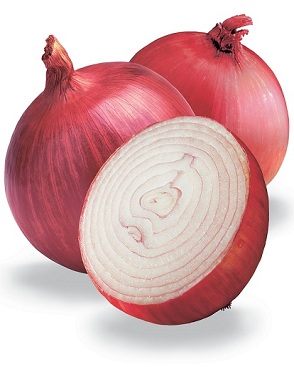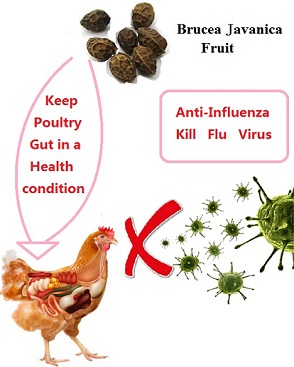- Plant-Based Protein
- Natural Plant Flavours
- Food and Dietary Supplement Ingredients
- Fruit Juice Powder
- Animal Nutrition Ingredients
- Water Soluble Ingredients
- Cosmetic Ingredients
- Unveiling the Therapeutic Potential of Rabdosia Rubescens: A Comprehensive Review
- What are the medicinal properties of Rabdosia Rubescens?
- Nutritional value of Orange Juice Powder compared to fresh orange juice.
- Processing Conditions and Nutritional Value of Orange Juice Powder
- Exploring the Versatility of Herbal Extracts in Food Flavors
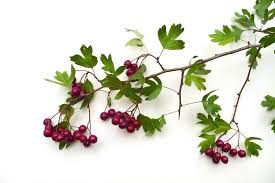
What are the health benefits of hawthorn leaf?
Welcome to our blog! Today, we are diving into the world of hawthorn leaf and uncovering its incredible health benefits. Whether you're a fan of herbal remedies or simply curious about natural alternatives, hawthorn leaf is definitely worth exploring.
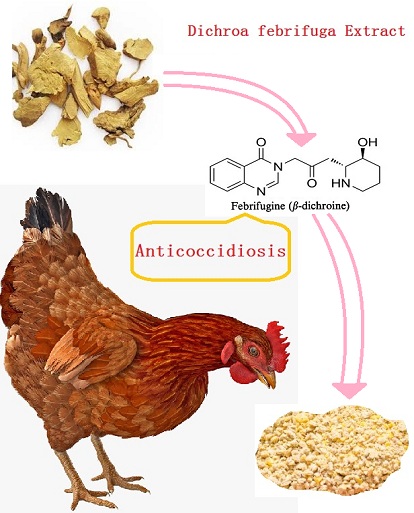

Medicinal herb, Dichroa febrifuga, Anticoccidiosis, Antimalarial, Use for poultry
Dichroa febrifuga, also known as Chang Shan, is a Chinese medicinal herb for protozoan diseases.Dichroa febrifuga crude extract was effective against Eimeria tenella infection in chickens. Febrifugine, an alkaloid, was isolated from this plant and its halogenated derivatives, were developed as anticoccidial chemicals. In the international situation of total prohibition of antibiotics, it can be used as an alternative to antibiotics.
Background
Parasitic and bacterial infections are causing large production losses and economic costs in the world broiler industry. The parasitic infection coccidiosis is estimated to cost € 285 million annually at EU level. Almost similar costs are inflicted by the bacteria causing necrotic enteritis.
The main treatment of coccidiosis, necrotic enteritis and the parasite infection histomoniasis is a prophylactic use of in-feed antibiotic and synthetic coccidiostats and histomonostats. Due to the risk of development of resistance to these therapeutic agents as well as drug residues in food products, the EU is considering phasing them out, as it was done for antibiotics as growth promoters in 2006.
Dichroa febrifuga, also known as Chang Shan, is a Chinese medicinal herb for protozoan diseases.Dichroa febrifuga crude extract was effective against Eimeria tenella infection in chickens. Febrifugine, an alkaloid, was isolated from this plant and its halogenated derivative, halofuginone, was developed as anticoccidial chemical. In the international situation of total prohibition of antibiotics, it can be used as an alternative to antibiotics.
What you may get from us: If you're developing a feed additive that contains medicinal herb of Dichroa febrifuga.I think you can find the information or products you need here.
Simple production process in our factory: After the plant is collected, It can be made straight powder. Or the raw material will be processed by solvent extraction, separation and purification, filtration, concentration, drying and other steps to form the final products. We may also design a prouction process based on your special requirements.
Through the physical and chemical processes, those compunds you don't want was removed, and the compunds preferred was accumulated. Which make the products achieve the best effects.
|
Dichroa febrifuga Straight powder or Dichroa febrifuga Extract |
||
|
Appearance |
Powder |
|
|
Color |
Brown |
|
|
Partical size |
Normally pass through 60mesh |
|
|
Pack size |
25 kg per paper drum |
|
|
Purity of active compunds |
Depends on your requriement |
By HPLC |
|
For pricing or more information, please call 86 29 88444632 or send an email to Sales@nutraherbsource.com.
|
||
Scientific Name: Dichroa febrifuga Lour
Common Names: blue evergreen hydrangea; Chinese quinine; Changshan;fever-flower
Family: Hydrangeaceae
Plant Description
Dichroa is an evergreen, 1-2 m tall shrub that belongs to the Saxifrage family (Saxifragaceae). It has elliptical or lanceolate leaves that are 6-25 cm long and 2-10 cm broad. The leaves are covered with soft or downy hairs (botanically called trichomes). The flower buds are white, but the flower petals turn bright blue when in full bloom. Just as hydrangeas (Hydrangea spp.), the flower color is affected by the acidity of the soil (linked to the availability of aluminum), and the more acidic the soil is, the bluer the flowers are. The fruits are dark blue berries that are 3.7 mm in diameter. The berries are not edible. The plants bloom from February to April, and the fruits ripen from May to August. The plants grow best in slightly acidic soil and are propagated by seeds or cuttings.
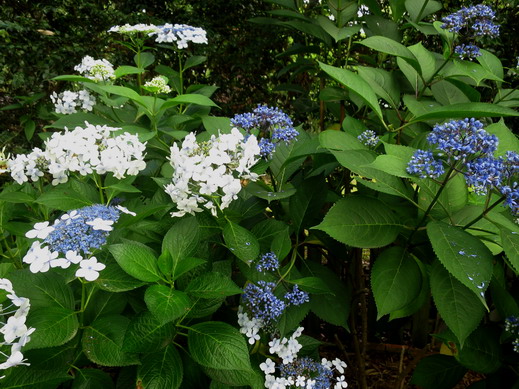
Major chemical constituents
The active principles of the roots of Dichroa febrifuga are alkaloids, isolated for the first time by Fu, Jang et al., and Koepfli et al. These alkaloids were named by Jang as dichroine A, B, C, which were substituted later by a-dichroine, Pdichroine, and y-dichroine, whereas Koepfli called these alkaloids febrifugine and isofebrifugine. Febrifugine is identical with p-dichroine and isofebrifugine with adichroine.
Febrifugine and isofebrifugine are isomeric quinazolin derivatives. They are readily interconverted under the influence of heat, acid, alkali, and solvents, e.g. isofebrifugine isomerizes to febrifugine by heat. The stereochemistry of febrifugine and its absolute configuration has also been determined.
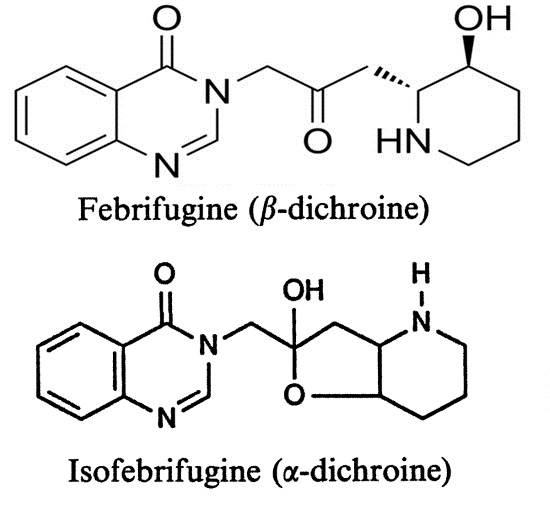
The total febrifugine and isofebrifugine content in roots was approximately 0.1 %, whereas the total content in leaves was found to be 0.7%. Moreover, umbelliferone and 4-quinazolone were also detected in roots of Dichroa febrifuga. The synthesis of febrifugine was also reported.
Introduction:
In China, Dichroa febrifuga Lour., which belongs to the Saxifragaceae family has been used for centuries against malarial fever. Extracts from either the roots or the leaves were effective for treating chicks infected with Plasmodium gallinaceum and in clinical cases of malaria. Among 600 plant extracts tested for their antimalarial effects, the extract of Dichroa febrifuga was found to be one of the most effective. An active quinazoline-type alkaloid isolated from the roots and having the molecular structure C16H2103N3 was designated dichroin B, and later renamed febrifugine. The alkaloids febrifugine and its stereoisomer, isofebrifugine, have been identified as the active components of the plant, and both exhibited in vitro antimalarial activity against chloroquine-sensitive and chloroquine-resistant Plasmodium falciparum. Febrifugine was found to be effective against Plasmodium vivax and more active than quinine against Plasmodium lophurae, Plasmodium gallinaceum, and Plasmodium cynomolgi. Because the high antimalarial activity was accompanied by gastrointestinal toxicity associated with, e.g., diarrhea, vomiting, and liver toxicity, the structure of febrifugine was used as a lead compound in the synthesis of some active molecules with lower toxicity that inhibited parasite growth both in vitro and in vivo. In addition, synthesis of a series of febrifugine derivatives as antimalarial drugs was performed by structural modifications at the quinazoline ring, the linker, or the piperidine ring, and antimalarial drug-discovery models were developed for screening and predicting efficacious febrifugine analogs. It has been demonstrated that most febrifugine analogs bearing a modified or unmodified 4- quinazolinone moiety are active, but analogs produced through modification of the side chain attached to the N3 position of the 4-quinazolinone ring have proved to be ineffective. Furthermore, a synthetically prepared racemic febrifugine was reported to be about half as effective as natural febrifugine. These results suggested that the 4-quinazolinone moiety, the nitrogen atom of the piperidine ring, and the hydroxyl group are necessary for the antimalarial activity, and that the absolute configuration of these functional groups plays an important role.
Traditional Uses in Chinese Medicine.
Dichroa is a bitter herb that is commonly used in Chinese herbal medicine where it is considered to have a cold energy that benefits the heart, liver, and lungs.
The leaves have powerful laxative (purgative) proprieties and have been used traditionally to treat stomach cancer.
In Nepal the juice extracted from the leaves has been used to treat coughs, colds and bronchitis and the root sap is used as a remedy for fever and indigestion.
A decoction made from the stem bark is used as a treatment for high fever, and a decoction made from the leaves is often used specifically to treat malaria fever. The root contains a variety of alkaloids that are considered to have emetic, expectorant, antipyretic and laxative properties.
Dichroa as Malaria Medicine
In traditional Chinese medicine, the herb is used to kill the parasite that causes malaria, but it is also thought to be effective against amoebas (a single-celled organism).
One of the plant’s substances febrifugine has been found effective against protozoa, especially parasitic protozoa in the Genus Plasmodium that causes malignant and benign third-world malaria fever.
Compared with quinine, a more familiar fever-lowering agent, febrifugine is reported to have much stronger effect.
Uses and Pharmacology
Dichroa febrifuga crude extract as Antiprotozoan(anticoccidial) in Poultry and in Ruminants
Coccidiosis and cryptosporidiosis are parasitic diseases caused by protozoa; they develop in various regions in the gut affecting poultry flocks and cattle, respectively, and they cause mild to severe lesions, weight loss, diarrhea and increased mortality. In poultry Dichroa febrifuga crude extract was effective against various Eimeria species: it acted early in the life cycle of coccidia, was effective against infections of Eimeria mitis in young broiler chickens, inhibited the parasite’s invasion of the host’s cecum during early stages of the life cycle, and later disturbed the parasite’s development by vacuolation of the schizonts. In calves, Dichroa febrifuga crude extract was effective in reducing the risk of cryptosporidiosis and decreased the intensity of diarrhea and fecal oocyst counts, when used in either preventive or therapeutic mode. In lambs, Dichroa febrifuga crude extract reduced diarrhea caused by cryptosporidiosis and reduced death rate. Dichroa febrifuga crude extract was efficacious against Cryptosporidium parvum also in vitro.
A study was conducted on broiler birds to evaluate the anticoccidial efficacy of an extract of Chinese traditional herb Dichroa febrifuga Lour. One hundred broiler birds were assigned to five equal groups. All birds in groups 1–4 were orally infected with 1.5 × 104 Eimeira tenella sporulated oocysts and birds in groups 1, 2 and 3 were medicated with 20, 40 mg extract/kg feed and 2 mg diclazuril/kg feed, respectively. The bloody diarrhea, oocyst counts, intestinal lesion scores, and the body weight were recorded to evaluate the anticoccidial efficacy. The results showed that D. febrifuga extract was effective against Eimeria infection; especially 20 mg D. febrifuga extract/kg feed can significantly increase body weight gains and reduce bloody diarrhea, lesion score, and oocyst excretion in comparison to infected-unmedicated control group.
Antimalarial activity
With drug resistance from medications such as chloroquine and quinine becoming prevalent, researchers have sought other antimalarial sources. Isolates of Dichroa febrifuga, febrifugine and isofebrifugine, were found to be the active components against malaria; however, chemists could not separate adverse effects (eg, nausea, vomiting, diarrhea) from their beneficial actions. Febrifugine exerts its antimalarial effects by impairing the haemazoin formation needed for parasite maturation at the trophozoite stage. Various analogues have been synthesized in an effort to minimize adverse effects and enhance bioavailability; some of these compounds have therapeutic indices greater than 10 times that of chloroquine. One study suggested that increased lipophilicity of the analogues was associated with improved antimalarial activity.
Animal and in vitro data
Febrifugine and isofebrifugine in certain preparations (eg, acetone extract) demonstrated high antimalarial activity against Plasmodium falciparum and Plasmodiumberghei. In a study evaluating the effects of an aqueous extract of Dichroa febrifuga against Plasmodium berghei in mice, a reduction in infection rate and an increase in mean survival time were observed.Two reports suggest that dichroa extracts alter nitric oxide (NO) concentrations. In mice infected with P. berghei, febrifugine 1 mg/kg/day orally reduced mortality and parasitemia, and increased NO production and plasma concentration, thus contributing to host defense against malaria infection.In an in vivo study, febrifugine significantly enhanced NO production in mouse peritoneal macrophages, with dose-dependent activations. However, another study investigating the effects of an aqueous extract of Dichroa febrifuga root demonstrated a decrease in NO production as well as tumor necrosis factor, which plays a role in endotoxin-mediated shock and inflammation. In mouse macrophages, NO synthase and NO serum levels were decreased, suggesting suppression of inflammatory response and possible use as an anti-inflammatory.
Dosage:
Natural compounds such ans plant extracts are used or evaluated as diet supplements to a alleviate the negative effects of coccidiosis. Anticoccidial outcomes are often indirectly assessed by survival rates, improved growth performance, feed conversion, intestinal lesions,and bloddy diarrhea.Tirals showed that Dichroa febrifuga extract,20mg/kg feed, significantly increased body weight gains and reduced bloody diarrhea,lesion score, and oocyst excretion.
- Prev:Medicinal herb-Uncaria tomentosa,Antibacterial, Anticoccidiosis,Immune stimulator
- Next:Medicinal herb-Brucea Javanica,Antibacterial, Anti influenza, Anticoccidiosis,poultry health



